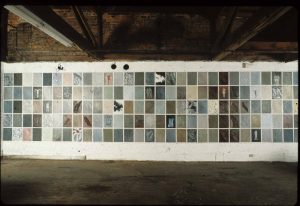As the culmination of my Learning from Artists’ Archives field experience, a studio archiving project with Asheville, NC artist Connie Bostic–which included digitization of slides and ephemera, creation of a detailed artwork inventory, and the recording of oral histories with and about Connie–ephemera, recordings, and digitized items from Bostic’s studio will be preserved as a collection of the North Carolina Room at Pack Memorial Library. Pack Library is Asheville’s central library branch, located downtown. The North Carolina Room houses special collections focusing on local history in Asheville.
Though the NC Room has many large photographic collections, this is the first living, individual artist collection at Pack–testament to Bostic’s living legacy within the community.
Bostic’s collection in the North Carolina Room will be celebrated and formally announced with a small exhibition at Pack Library, tentatively planned for early spring.
The collection will contain video oral histories, physical clippings, posters, and other ephemera, and an inventory with thumbnail images and metadata documenting 670 of Bostic’s paintings, drawings, prints, and mixed media works. Researchers will be able to access higher resolution digital images of items in the inventory upon request.
These items join the North Carolina Collection’s already existing collection of ephemera documenting Bostic’s work at World and Zone One Contemporary art galleries, linchpins of Asheville’s burgeoning downtown art scene from the mid-eighties to the early aughts.
This partnership could not have come to fruition without the dedicated effort of Zoe Rhine and Ione Whitlock of the North Carolina Room, as well as Connie Bostic herself.
As this “Learning from Artist Archives” project and that of my colleagues (see Colin Post’s Art Documentation article for a detailed account of his archiving collaboration with Cornelio Campos and the Durham Public Library; see also Kelsey Moen’s project with Alia El-Bermani, and Kim Henze’s project with Susan Harbage Page) demonstrates, public libraries and other local repositories can play a valuable and necessary role in preserving and making accessible the materials of artists in their communities.

